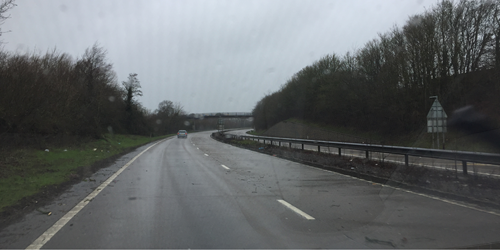Part of the challenge of riding a motorcycle is adjusting our riding to deal with different road surfaces and conditions. Poor weather, diesel spills, mud, service covers and painted road markings can all test our hazard perception skills and riding abilities.
Signage may give warnings of upcoming hazards, but mostly, bikers are reliant on early observations and riding skill. There may be other clues to hazards; where HGVs turn, or at roundabouts, there may be diesel spills; where there are building sites or farms and field entrances, there may be mud on the road. Even brand new road surfaces can be slippery under certain conditions.
Experienced bikers will allow themselves sufficient time and space to observe what is ahead, so avoiding action can be taken if necessary. Bikers’ safety depend on the circumstances around the hazard, such as road conditions, weather, the limitations of your bike, your skill and fitness as a rider.
Keep looking well ahead for surface irregularities. If you can do so without danger, avoid them. If you can’t, take avoiding action safely, make rear observations, slow down and take an upright riding position.
Be an attentive rider and look out for potentially hazardous road surfaces, such as:
- Potholes - which can pose a serious hazard when motorcycling; they can damage our bike’s suspension and even cause tyres to burst
- Paint - can be a hazard especially when wet. Avoid painted areas if possible
- Repairs - these can be temporary, or uneven, and the joints can be slippery in wet conditions
- Oil/diesel spills - look out for rainbow coloured areas on the road surface - this indicates the presence of a spill which makes the tarmac as slippery as ice
- Mud - especially in rural areas and near building sites. Mud can be problematic when braking or turning. Slow down and take avoiding action if you can do so safely
- Service covers - as well as looking out for raised or loose covers, pay particular attention in wet conditions, as worn metal becomes polished and is a particular hazard for two-wheelers
- Gravel - loose stones severely effect grip, take note of warning signs and slow down
- Leaves - wet leaves on the road can be slippery which compromises tyre grip
- Standing water - makes skids and aquaplaning more likely. Reduce speed to maintain tyre grip by easing out of the throttle rather than using the brakes, slowing down until grip is regained
- Black ice - during colder months this can be particularly hard to spot. As temperatures fall extra caution is advised and riding speed must be reduced
- Shaded sections and isolated stretches - which can remain wet or icy long after other parts of the road surface have dried out.
We should always be prepared to adjust our riding according to the conditions. Careful observations, appropriate speed and adequate braking distances are all essential for a safe journey.
